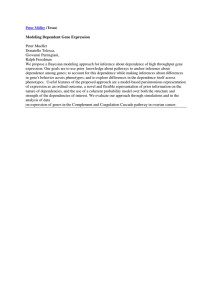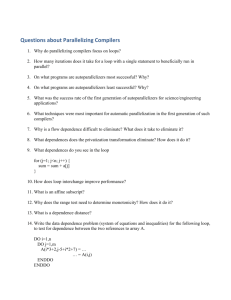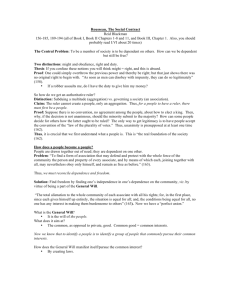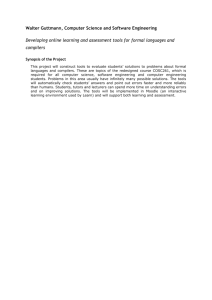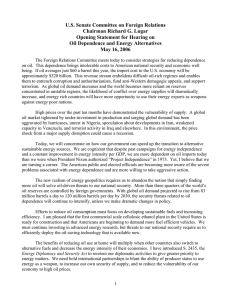A Crash Course in Compilers for Parallel Computing Mary Hall Fall, 2008
advertisement
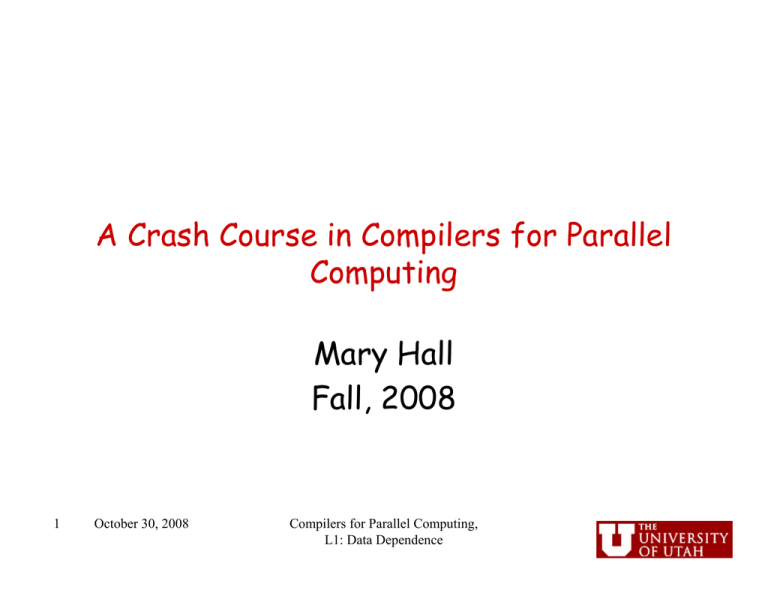
A Crash Course in Compilers for Parallel
Computing
Mary Hall
Fall, 2008
1
October 30, 2008
Compilers for Parallel Computing,
L1: Data Dependence
Outline of Lecture
I.
•
Introduction to course
Relevance to compiler researchers, parallel
programmers, architects
II. What is Data Dependence?
•
•
•
Define for scalar variables
Extend to arrays and loop
Brief discussion of pointer-based
computations and objects
III. Loop iteration reordering
•
•
2
For exploiting parallelism
For managing locality
October 30, 2008
Compilers for Parallel Computing,
L1: Data Dependence
Suggested Reading
• Intent of course is to be selfcontained (no outside reading needed)
• Some material taken from:
– Optimizing Compilers for Modern
Architectures by Randy Allen and Ken
Kennedy, Morgan Kaufmann Publishers,
2002.
3
October 30, 2008
Compilers for Parallel Computing,
L1: Data Dependence
I. Introduction and Motivation
• Foundation for compiler research ...
• ... But there are other opportunities
• Parallel Programmers:
– Learn to reason about correct and
efficient parallel programs
• Architects:
– Capabilities and limitations of compilers
4
October 30, 2008
Compilers for Parallel Computing,
L1: Data Dependence
I.
Introduction and Motivation,
Why now?
• Technology trends have led us to the
“multi-core paradigm shift”
– Can no longer rely on performance from
increasing clock rates
• Parallel programming will become
dominant
– To achieve performance
– To enhance software capability
5
October 30, 2008
Compilers for Parallel Computing,
L1: Data Dependence
Overview of “Crash Course”
• L1: Data Dependence Analysis and
Parallelization
• L2: Loop Reordering Transformations
• L3: Locality Analysis and Optimization
• L4: Autotuning Compiler Technology
6
October 30, 2008
Compilers for Parallel Computing,
L1: Data Dependence
II. Data Dependence
• Definition:
Two memory accesses are involved in a data dependence if they may
refer to the same memory location and one of the references is a
write.
A data dependence can either be between two distinct program
statements or two different dynamic executions of the same
program statement.
• Two important uses of data dependence information (among others):
Parallelization: no data dependence between two computations Î
parallel execution safe
Locality optimization: absence of data dependences & presence of
reuse Î reorder memory accesses for
better data locality
7
October 30, 2008
Compilers for Parallel Computing,
L1: Data Dependence
More generally, How are Data
Dependences Used?
• Scalar analog: data-flow analysis
– Partial redundancy elimination, loop-invariant code motion, ...
• Identify parallel loops
(data parallel)
• Identify independent tasks (task parallel)
• Manage communication and locking
– Possible dependence Î protect with lock
– Proven dependence Î communicate to use
• Determine safety of reordering transformations and
data structure transformations
– For parallelism and locality
• Exploiting instruction-level parallelism
– E.g., Software pipelining
• Hints to hardware
– Prefetch, coherence, ...
8
October 30, 2008
Compilers for Parallel Computing,
L1: Data Dependence
Data Dependence of Scalar Variables
True (flow) dependence
a
Anti-dependence
a
Output dependence
a
a
=
=a
=a
=
=
=
Input dependence (for locality)
=a
=a
Definition: Data dependence exists from a reference
instance i to i’ iff
either i or i’ is a write operation
i and i’ refer to the same variable
i executes before i’
9
October 30, 2008
Compilers for Parallel Computing,
L1: Data Dependence
Some Definitions (from Allen & Kennedy)
• Definition 2.5:
– Two computations are equivalent if, on the same inputs,
• they produce identical outputs
• the outputs are executed in the same order
• Definition 2.6:
– A reordering transformation
• changes the order of statement execution
• without adding or deleting any statement executions.
• Definition 2.7:
– A reordering transformation preserves a dependence if
• it preserves the relative execution order of the dependences’
source and sink.
10
October 30, 2008
Compilers for Parallel Computing,
L1: Data Dependence
Fundamental Theorem of Dependence
• Theorem 2.2:
– Any reordering transformation that preserves
every dependence in a program preserves the
meaning of that program.
• Now we will discuss abstractions and
algorithms to determine whether
reordering transformations preserve
dependences...
11
October 30, 2008
Compilers for Parallel Computing,
L1: Data Dependence
In Today’s Lecture: Parallelizable Loops
Forall or Doall loops:
Loops whose iterations can execute in parallel (a particular
reordering transformation)
Example
forall (i=1; i<=n; i++)
A[i] = B[i] + C[i];
Meaning?
Each iteration can execute independently of others
Free to schedule iterations in any order
Why are parallelizable loops an important concept?
Source of scalable, balanced work
Common to scientific, multimedia, graphics & other domains
12
October 30, 2008
Compilers for Parallel Computing,
L1: Data Dependence
Data Dependence for Arrays
LoopCarried
dependence
for (i=2; i<5; i++)
A[i] = A[i-2]+1;
for (i=1; i<=3; i++)
A[i] = A[i]+1;
LoopIndependent
dependence
• Recognizing parallel loops (intuitively)
– Find data dependences in loop
– No dependences crossing iteration boundary
parallelization of loop’s iterations is safe
13
October 30, 2008
Compilers for Parallel Computing,
L1: Data Dependence
Î
0. Pre-pass: Loop Normalization
• We will talk about memory accesses with respect to
the iteration spaces of loop nests.
• Assumes loop iteration counts begin at “1” and step by
“1”
• Loops can always be normalized to ensure this
property:
for (i=4; i<=12; i+=2)
A[i] = …
14
October 30, 2008
for (i=1; i<=5; i++)
A[i*2 + 2] = ...
Compilers for Parallel Computing,
L1: Data Dependence
1. Characterize Iteration Space
for (i=1;i<=5; i++)
for (j=i;j<=7; j++)
...
1≤i≤5
i≤j≤7
i
j
• Iteration instance: represented as coordinates in iteration space
– n-dimensional discrete cartesian space for n deep loop nests
• Lexicographic order: Sequential execution order of iterations
[1,1], [1,2], ..., [1,6],[1,7],
[2,2], [2,3], ..., [2,6], ...
• Iteration I (a vector) is lexicographically less than I’, I<I’ , iff
there exists c ( i1, …, ic-1) = (i’1, …, i’c-1) and ic < i’c .
15
October 30, 2008
Compilers for Parallel Computing,
L1: Data Dependence
2. Compare Memory Accesses across
Dynamic Instances in Iteration Space
N = 6;
for (i=1; i<N; i++)
for (j=1; j<N; j++)
A[i+1,j+1] = A[i,j] * 2.0;
i
I’=[2,2],
Read A[2,2]
I=[1,1],
j
Write A[2,2]
How to describe relationship between two dynamic instances?
e.g., I=[1,1] and I’=[2,2]
16
October 30, 2008
Compilers for Parallel Computing,
L1: Data Dependence
Distance Vectors
N = 6;
for (i=1; i<N; i++)
for (j=1; j<N; j++)
A[i+1,j+1] = A[i,j] * 2.0;
• Distance vector = [1,1]
• A loop has a distance vector D if there exists data
dependence from iteration vector I to a later
vector I’, and
D = I’ - I.
• Since I’ > I, D >= 0.
(D is lexicographically greater than or equal to 0).
17
October 30, 2008
Compilers for Parallel Computing,
L1: Data Dependence
Distance and Direction Vectors
• Distance vectors: (infinitely large set)
⎞
⎛ 0 0 0
⎞⎛
⎞ ⎛
… 0 ⎟ ⎜ 1 … 1 … 1 ⎟ …⎜ n … n … n ⎟
⎜
⎝ 0 1 2
0
n ⎠ ⎝ –n
0
n ⎠
n ⎠ ⎝ –n
• Direction vectors: (realizable if 0 or
lexicographically positive)
([=,=],[=,<],[<,>], [<,=], [<.<])
• Common notation:
0 =
+ <
- >
+/- *
18
October 30, 2008
Compilers for Parallel Computing,
L1: Data Dependence
Parallelization Test:
1-Dimensional Loop
• Examples:
for (j=1; j<N; j++)
A[j] = A[j] + 1;
for (j=1; j<N; j++)
B[j] = B[j-1] + 1;
• Dependence (Distance and Direction) Vectors?
• Test for parallelization:
– A loop is parallelizable if for all data dependences D e
D=0
19
October 30, 2008
Compilers for Parallel Computing,
L1: Data Dependence
D,
n-Dimensional Loop Nests
for (i=1; i<=N; i++)
for (j=1; j<=N; j++)
A[i,j] = A[i,j-1]+1;
for (i=1; i<=N; i++)
for (j=1; j<=N; j++)
A[i,j] = A[i-1,j-1]+1;
• Distance and direction vectors?
• Definition:
D = (d1, … dn) is loop-carried at level i if di is the first
nonzero element.
20
October 30, 2008
Compilers for Parallel Computing,
L1: Data Dependence
Test for Parallelization
The i th loop of an n-dimensional loop is parallelizable if
there does not exist any level i data dependences.
The i th loop is parallelizable if for all dependences
D = (d1, … dn),
either
(d1, … di-1) > 0
or
(d1, … di) = 0
21
October 30, 2008
Compilers for Parallel Computing,
L1: Data Dependence
Parallelization Algorithm
• For each pair of dynamic accesses to the same
array within a loop nest:
– determine if there exists a dependence
between that pair
• Key points:
– n2 tests for n accesses in loop!
– a single access is compared with itself
– includes accesses in all loops within a nest
22
October 30, 2008
Compilers for Parallel Computing,
L1: Data Dependence
Dependence Testing
• Question so far:
• What is the distance/direction (in the
iteration space) between two dynamic
accesses to the same memory location?
• Simpler question:
• Can two data accesses ever refer to the
same memory location?
for (i=11;i<=20;i++)
A[i] = A[I-1]+ 3;
23
October 30, 2008
for (i=11;i<=20;i++)
A[I] = A[I-10]+ 1;
Compilers for Parallel Computing,
L1: Data Dependence
Restrict to an Affine Domain
for (i=1; i<N; i++)
for (j=1; j<N j++) {
A[i+2*j+3, 4*i+2*j, 3*i] = ...;
... = A[1, 2*i+1, j];
}
• Only use loop bounds and array indices
which are integer linear functions of loop variables.
• Non-affine example:
for (i=1; i<N; i++)
for (j=1; j<N j++) {
A[i*j] = A[i*(j-1)];
A[B[i]] = A[B[j]];
}
24
October 30, 2008
Compilers for Parallel Computing,
L1: Data Dependence
Equivalence to Integer Programming
• Need to determine if F(i) = G(i’), where i and i’ are
iteration vectors, with constraints i,i’ >= L, U>= i, i’
• Example:
for (i=2; i<=100; i++)
A[i] = A[i-1];
• Inequalities:
0 <= i1 <= 100,
integer vector I,
i2 = i1 - 1,
AI <= b
• Integer Programing is NP-complete
– O(size of the coefficients)
25
n)
–
O(n
October 30, 2008
Compilers for Parallel Computing,
L1: Data Dependence
i2 <= 100
Example Using SUIF Calculator
iterr = [
SUBROUTINE MATTRN(A, N)
INTEGER N
REAL A(N,N)
INTEGER NM1, J, I
REAL TEMP
NM1 = N - 1
IF (NM1 .EQ. 0) RETURN
DO 200 J = 1, NM1
DO 100 I = J+1, N
TEMP = A(I,J)
A(I,J) = A(J,I)
A(J,I) = TEMP
100 CONTINUE
200 CONTINUE
...
26
October 30, 2008
1 <= jr
jr <= nm1
jr+1 <= ir
ir <= n
]
iterw = [
1 <= jw
jw <= nm1
jw+1 <= iw
iw <= n
]
access = [
ir = jw
jr = iw
]
dependence =
{iterr,iterw,access}
dependence.intsol()
Compilers for Parallel Computing,
L1: Data Dependence
Such Formulations Often Overkill and
Typically Used Only When Needed
• Consider the following simple, exact test
• Definition:
– SIV= Single Induction Variable
• Strong SIV:
– An SIV subscript for loop index I is strong if it
has the form <aI + c1, aI’ + c2>
• Dependence distance can be calculated
exactly as follows:
– d = I’ - I = (c1 - c2) / a
27
October 30, 2008
Compilers for Parallel Computing,
L1: Data Dependence
Summary of Lecture
• Data dependence is a fundamental concept in
compilers for high-performance computing.
• Data dependence can be used to determine the
safety of reordering transformations
– preserving dependences = preserving “meaning”
• Iteration, distance and direction vectors are
abstractions for understanding whether
reordering transformations preserve
dependences.
• Dependence testing on array accesses in loops
has been shown to be equivalent to integer
programming.
28
October 30, 2008
Compilers for Parallel Computing,
L1: Data Dependence
Next Week:
• How do we use dependence
information to decide safety of
reordering transformations other
than parallelization?
29
October 30, 2008
Compilers for Parallel Computing,
L1: Data Dependence


